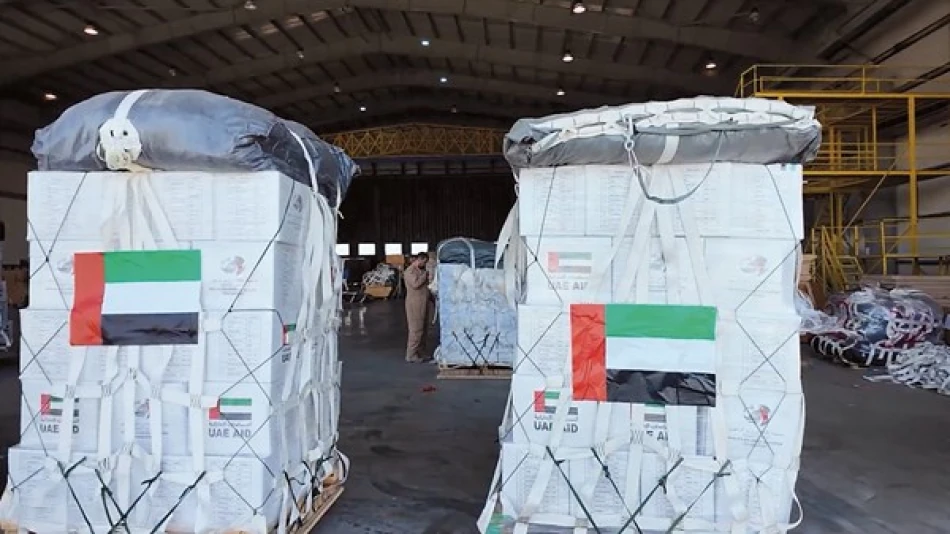
UAE Airlifts Aid to Support Gaza Residents in Crisis
UAE's Gaza Relief Operations Set New Standard for Humanitarian Crisis Response
The United Arab Emirates has positioned itself as the dominant force in Gaza's humanitarian relief efforts, contributing 44% of all international aid to the besieged territory through an unprecedented multi-modal operation that combines airdrops, land convoys, and maritime deliveries. As Gaza faces what UN agencies describe as the world's worst famine scenario, the UAE's "Operation Gallant Knight 3" demonstrates how Gulf states are reshaping Middle Eastern diplomacy through humanitarian leadership rather than traditional political channels.
Precision Airdrops Bypass Ground Obstacles
The UAE's "Birds of Goodness" initiative has completed its 57th airdrop mission in coordination with Jordan, delivering aid to Gaza's most inaccessible areas. Operating from Jordan's King Abdullah II Air Base, Emirati and Jordanian aircraft have delivered 3,775 tons of food and relief supplies using 196 specialized aircraft missions.
This aerial approach reflects a strategic shift in crisis response. Unlike traditional aid delivery that relies on ground access and ceasefire agreements, the UAE's model operates independently of political negotiations. The precision required for these operations—ensuring supplies reach intended recipients in a dense urban environment—showcases military-grade logistics capabilities typically reserved for combat operations.
Land and Sea Routes Complement Air Operations
Beyond airdrops, 58 Emirati trucks entered Gaza yesterday through various border crossings, continuing water pipeline extension projects from desalination plants. The UAE has also deployed maritime assets, including the vessel Khalifa, which delivered 7,166 tons of supplies, including 4,372 tons of food materials.
Infrastructure Investment Addresses Root Causes
The UAE's approach extends beyond emergency relief to sustainable infrastructure development. The country has established six desalination plants producing two million gallons daily, serving over 600,000 people. A new 6.7-kilometer water pipeline connecting Egyptian desalination facilities to southern Gaza represents the largest project of its kind.
This infrastructure focus distinguishes the UAE's strategy from traditional humanitarian responses. Rather than merely addressing symptoms, the Emirates is building long-term capacity to support Gaza's 2.3 million residents. The water project alone provides 15 liters per person daily, crucial given that over 80% of Gaza's water facilities have been damaged.
Food Security Through Local Production
The UAE has deployed automated bakeries and supports 21 field bakeries producing bread daily, addressing acute shortages that emerged early in the crisis. Over 50 charitable kitchens operate under Emirati support, while the UAE Red Crescent distributed 13 million iftar meals during Ramadan, reaching over two million people.
Geopolitical Implications for Gulf Diplomacy
The UAE's Gaza operations signal a broader transformation in Gulf state foreign policy. By leading humanitarian efforts rather than following traditional diplomatic channels, the Emirates positions itself as an indispensable regional actor. This approach mirrors successful UAE strategies in Yemen, Syria, and Lebanon, where humanitarian leadership created political influence.
The coordination with Jordan is particularly significant, demonstrating how the UAE leverages partnerships to overcome geographical constraints. This model could reshape how landlocked crises receive international support, with Gulf financial resources combined with regional logistical capabilities.
Market and Economic Dimensions
The scale of UAE's commitment—representing nearly half of all international Gaza aid—reflects the country's strategic use of humanitarian investment. Unlike traditional donor countries that face domestic political pressure over foreign aid spending, the UAE's centralized decision-making enables rapid, large-scale responses.
This approach creates soft power returns that traditional military or diplomatic investments cannot achieve. The UAE's visibility in Gaza relief efforts enhances its regional standing while demonstrating capabilities that extend beyond oil wealth to operational excellence in crisis management.
Crisis Severity Demands Sustained Response
UN data reveals the humanitarian catastrophe's scope: 39% of Gaza's population goes days without food, while over 500,000 people—nearly a quarter of the population—face famine-like conditions. Palestinian medical sources report 154 deaths from malnutrition, including 89 children, underscoring the crisis's urgency.
The UAE's response scale suggests recognition that Gaza's crisis requires state-level resources rather than traditional NGO capabilities. By treating humanitarian response as a strategic priority requiring military-grade logistics and infrastructure investment, the UAE has established a new benchmark for crisis intervention that other regional powers will likely need to match.
 Layla Al Mansoori
Layla Al Mansoori







